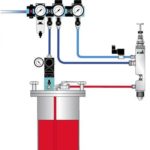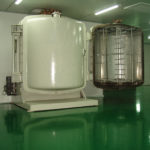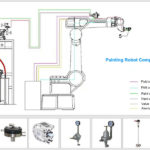Dust-free clean room, also known as clean workshop or clean room is a specially designed room that excludes particles from the air within a certain space range, harmful air, bacteria and other pollutants, and controls the indoor temperature, cleanliness, indoor pressure, air velocity and air flow distribution, illumination and static electricity within a certain range of requirements. No matter how the room out air conditions change, the interior can maintain the characteristics of cleanliness, temperature, humidity and pressure as per setting. Clean room is a crucial part for paint shop construction.
The classification of dust-free workshop is mainly divided according to the number of dust particles in workshop atmosphere. According to the international standard ISO 14644-1, clean rooms can be divided into the following classes:
- ISO Class 1: No more than 1 particle larger than φ0.5 μm per cubic foot of air. This is the highest level of dust-free workshop, which is mainly used to manufacture products that are extremely sensitive to dust, such as semiconductors, integrated circuits, etc.
- ISO Class 2: No more than 4 particles larger than φ0.5 μm per cubic foot of air. This level clean room is often used to manufacture extremely demanding products, such as high-tech electronics.
- ISO Class 3: No more than 35 particles larger than φ0.5 μm per cubic foot of air. This level cleanroom is usually used to manufacture dust-sensitive but slightly less demanding products, such as optical instruments, precision machinery, etc
- ISO Class 4: No more than 352 particles larger than φ0.5 μm per cubic foot of air. This level of dust-free workshop is used to manufacture products that have certain requirements for dust, such as pharmaceuticals, cosmetics, etc.
- ISO Class 5: No more than 3,520 particles greater than φ0.5 μm per cubic foot of air. This level of dust-free workshop is often used for general industrial production and scientific research experiments
Here’s a table list of each class clean room standards over different sizes of particles
| Clean class | ≥mentioned particle size maximum concentration(pcs/cbm) | |||||
| 0.1µm | 0.2µm | 0.3µm | 0.5µm | 1µm | 5µm | |
| ISO Class 1 | 10 | 2 | ||||
| ISO Class 2 | 100 | 24 | 10 | 4 | ||
| ISO Class 3 | 1000 | 237 | 102 | 35 | 8 | |
| ISO Class 4 | 10000 | 2370 | 1020 | 352 | 83 | |
| ISO Class 5 | 100000 | 23700 | 10200 | 3520 | 832 | 29 |
| ISO Class 6 | 1000000 | 237000 | 102000 | 35200 | 8320 | 293 |
| ISO Class 7 | 352000 | 83200 | 2930 | |||
| ISO Class 8 | 3520000 | 832000 | 29300 | |||
| ISO Class 9 | 35200000 | 8320000 | 293000 | |||
Upon understanding the classification of a clean room, we also need to know how to maintain the workshop cleanliness. First of all, the dust-free workshop design must be reasonable, including air flow, temperature control, humidity regulation, etc. Secondly, the equipment and materials in the workshop should be selected appropriately to avoid dust. In addition, the operation in the workshop should also be standardized to avoid the generation of dust caused by human factors.
Layout requirements of dust-free workshop construction
Here’s a sample of YYO033-2000 “Sterile Medical Device Production Management Standards” with guidelines for setting the cleanliness. Attention should be paid to the following aspects in the design of the dust-free workshop:
- The personnel area of clean room should not be less than 4m (except for corridors, equipment and other items) to ensure a safe operation area
- According to production process, the flow of people and logistics is reasonable. It should also be equipped with sanitary ware room, laundry room, temporary storage room, station appliance cleaning room, etc., each room is independent of each other, and the area of the clean workshop should be adapted to the production scale under the premise of ensuring the basic requirements
- There is no pollution in the same clean room (zone) or between neighbour clean rooms (zones).
- According to the air cleanliness level, it can be marked according to the flow of people, from low to high: the workshop is from the inside to the outside, from high to low
Dust-free workshop temperature and humidity requirements
1- Adapt to the production process requirements
2- When there are no special requirements in the production process, the temperature of the clean room (area) with air cleanliness of class 2 and class 4 should be 20 °C ~ 24 °C and the relative humidity should be 45% ~ 65%; When there are special requirements, it should be determined according to the process requirements.
3- The temperature of the personnel purification room should be 16°C~20°C in winter and 26°C~30°C in summer.
In actual applications, the classification and management of clean rooms are very important. For enterprises that need to manufacture high-precision products, the dust-free workshop cleanliness directly decides the product quality and performance. Therefore, enterprises need to choose the appropriate dust-free workshop grade according to their own production needs and product requirements, manage and maintain them in strict accordance with the requirements.
At the same time, operation and maintenance of the dust-free workshop also requires professional team and technical support. Including the maintenance of air purification equipment, cleanliness monitoring, operator training, etc. Only by ensuring the stable operation and efficient maintenance of the dust-free workshop can the quality of products and the smooth progress of production be guaranteed.
In short, the classification and management of clean room is a complex and important work. For enterprises, choosing the right level of dust-free workshop and carrying out effective management and maintenance is the key to ensuring product quality and smooth production. At the same time, with the continuous progress of science and technology and the continuous improvement of people’s product quality requirements, the technology and management of dust-free workshops will continue to improve and develop.




